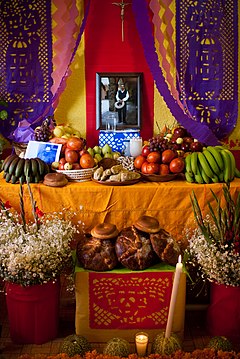Today Mexicans are celebrating Día de Muertos ... the day of the dead. The multi-day holiday involves family and friends gathering to pray for and remember friends and family members who have died, and helping support their spiritual journey. In Mexican culture, as it is in many cultures, death is viewed as a natural part of the human cycle. Mexicans view it not as a day of sadness but as a day of celebration because their loved ones awake and celebrate with them.

I like the fact that we can devote one day for the departed souls so we can get on with life the rest of the year, versus celebrating different days for every person you know. In our family, we started doing a thanksgiving kirtan a few years ago in remembrance of our departed elders. Its amazing how the love for ancestors appears in different cultures.
I am also especially fascinated by the similarities between words in languages. Dia, day and divas/din in Spanish, English, Punjabi/Hindi/Sanskrit are similar. And meurtos and mrityu are again similar in Spanish and Punjabi/Hindi/Sanskrit. And of course, we have mortal in English potentially using the same root. To me it is obvious that some of the roots of these words come from an ancient language that was common between humans.
So many words are then made from these words. For example, in Punjabi/Hindi/Sanskrit, Amrit, or the nectar of life is A-mrit ... not dying! The city established by Guru Arjan is called Amritsar, A-mrit-sar ... the sarovar of A-mrit ... or the lake of perpetual life.
The common roots of words, the commonality of human experience and then using those building blocks and developing languages and related culture is truly amazing. The soul is compelled in amazement, to say, Wow! Waheguru!
Following is a playlist of shabads for Antim Sanskar/Death/Funeral Services:

I like the fact that we can devote one day for the departed souls so we can get on with life the rest of the year, versus celebrating different days for every person you know. In our family, we started doing a thanksgiving kirtan a few years ago in remembrance of our departed elders. Its amazing how the love for ancestors appears in different cultures.
I am also especially fascinated by the similarities between words in languages. Dia, day and divas/din in Spanish, English, Punjabi/Hindi/Sanskrit are similar. And meurtos and mrityu are again similar in Spanish and Punjabi/Hindi/Sanskrit. And of course, we have mortal in English potentially using the same root. To me it is obvious that some of the roots of these words come from an ancient language that was common between humans.
So many words are then made from these words. For example, in Punjabi/Hindi/Sanskrit, Amrit, or the nectar of life is A-mrit ... not dying! The city established by Guru Arjan is called Amritsar, A-mrit-sar ... the sarovar of A-mrit ... or the lake of perpetual life.
The common roots of words, the commonality of human experience and then using those building blocks and developing languages and related culture is truly amazing. The soul is compelled in amazement, to say, Wow! Waheguru!
Following is a playlist of shabads for Antim Sanskar/Death/Funeral Services:
 Singing oneness!
Singing oneness!
0 Comments